|
Junkers Ju 52 "Toucan"
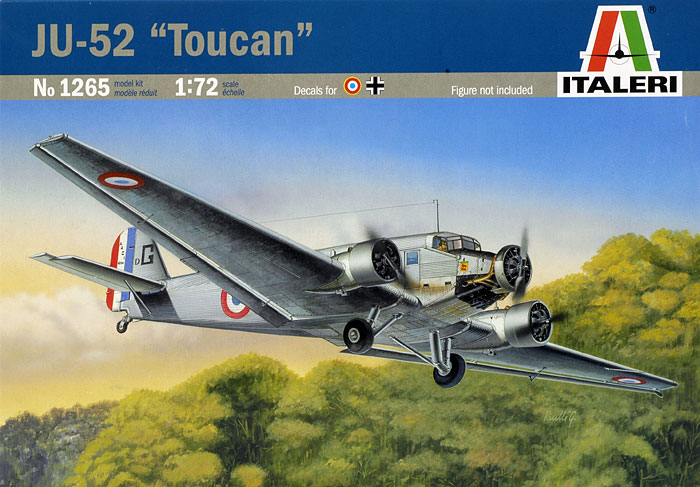
Italeri, 1/72 scale
S u m m a r y
|
|
Catalogue Number: |
Italeri No. 1265 -
Junkers Ju 52 "Toucan" |
|
Scale: |
1/72 |
| Contents and
Media: |
159
part in dark green plastic; 15 parts in clear; markings for
five aircraft. |
| Price: |
GBP£9.35 available online from Hannants website and
retailers worldwide |
| Review Type: |
FirstLook |
| Advantages: |
Classic kit that
stands the test of time; convincing corrugated surface;
plenty of options (spats, skis, armed and unarmed etc);
colourful and varied marking options; some additional work
and parts will be required to create the French "Toucan"
variant |
| Disadvantages: |
A little bit of fine
flash on some parts |
|
Recommendation: |
Recommended |
Reviewed by Brett Green

Italeri's 1/72 scale Ju 52 Toucan will
be available online from Squadron.com
The Junkers Ju 52, nicknamed "Tante Ju" (Auntie Ju), was
a bomber and transport aircraft. Production spanned from 1932 to 1945.
The Ju 52 saw widespread civil and military service both during WWII by
the Luftwaffe, and post war in many countries. Eight Junkers Ju 52s
remain airworthy today.
Italeri released their original Ju 52 kit in the 1970s. Despite its age,
the mouldings are holding up well and the overall effect is still
impressive, especially the characteristic corrugations that cover the
airframe.
Italeri's latest version of the Ju 52 comprises around 159 parts in
dark green coloured, long run injection moulded
styrene, and an additional 15 injection moulded clear parts. All the parts feature small sprue attachment
points and are crisply moulded. There are no sink marks present on
visible surfaces, and only a little fine flash around some of the parts.
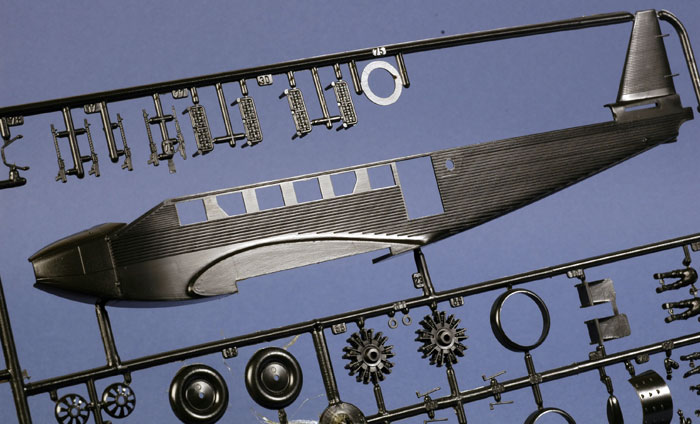
Click the thumbnails below to view larger
images:
[../../../photogallery/photo00017393/real.htm]
The Ju 52 featured a unique corrugated surface, and the kit depicts this
very well. Elsewhere, surface details are represented by very finely
raised lines.
A basic interior is supplied, with bench seats and a stretcher in the
cabin plus several figures.
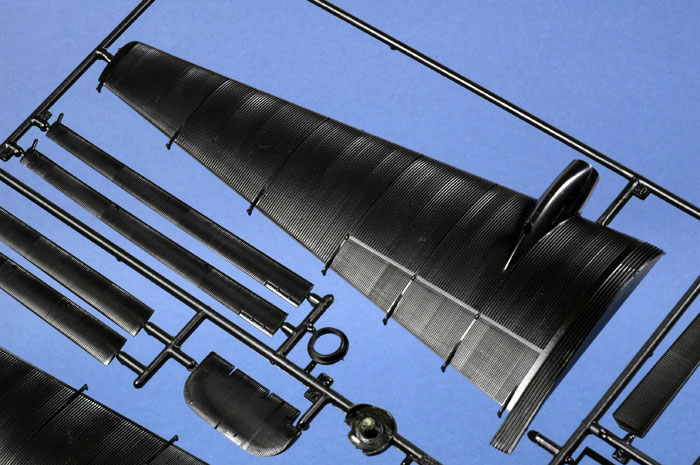
Options abound in the boxing, with standard undercarriage provided, plus
large spats and skis if desired. Clear parts are also provided for
either the armed or unarmed version of the Ju 52.
The transparencies are cleanly moulded, thin and quite clear, with
crisply raised framing.
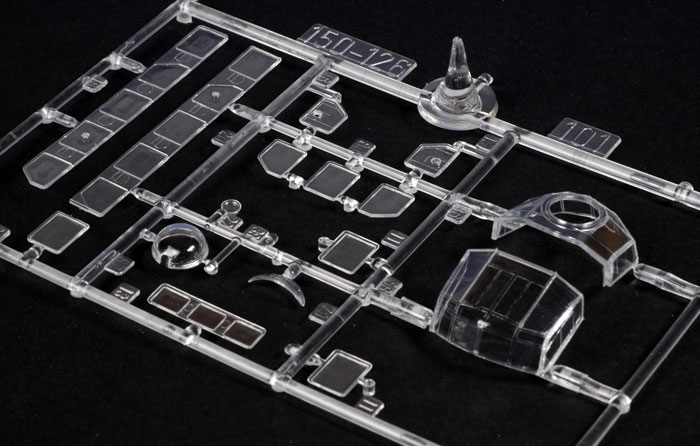
Kit engineering is conventional. The wings and tailplanes are secured with the
assistance of slots and tabs. The other parts, including the fuselage
halves, feature locating pins.
The big decal sheet is a real highlight, with one post-war French
"Toucan" and four Luftwaffe examples provided in desert, winter plus
pre-war and wartime camouflage colours.
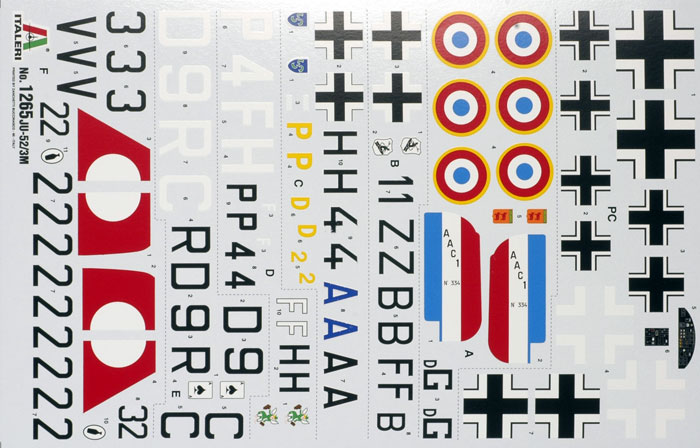
Decals
are nicely printed with a satin texture and minimal carrier film.
Registration on my decals was perfect.
Italeri's 1/72 scale Junkers Ju 52 is just as good today as it was when
it was first released, and stands up well in comparison to more recent
releases in this scale.
Whether you want to depict Tante Ju in civil or military guise,
Italeri's kit will do the job.
Recommended.
Peter Willicks has offered
some additional information about construction of the model as the
French "Toucan" variant, and about the colours, markings and decal
options:
General Remarks:
Straight from the box the kit can be build as a Ju 52
g5e or g6e. Earlier and later subtypes of the Ju 52 need some rescribing/rebuilding,
as they had different cargo doors, extra doors on the right side of the
fuselage. Many Ju 52 had much smaller undercarriage struts than those
included in the kit. These can be used for early Passenger-, transport-
or bomber aircraft and for the latest versions including the AAC 1
"Toucan".
Finally the prop blades are to broad, those of the Heller Ju and even
those of the old Airfix kit are better.
The decal options of the actual kit:
A. The "Toucan"
The Toucan used the smaller main-wheels of the C-47.
Strangely, the box art depicts a Toucan with these wheels, but they're
not included in this kit, but had been part of the passenger kit of the
Ju 52 which had been produced by Italeri too. The Toucan had additional
square shaped inlets under each engine. These inlets are included in the
Ju 52 from Heller and Airfix. The Exhausts of the Toucan were much
longer than those depicted in the instructions and protruded from the
backside of the nacelles. The parts are on the sprues but marked as "not
to use". Finally, the Toucan had an extra door on the starboard side of
the fuselage, straight after the cockpit.
B. 1Z + BF
This can be build straight from the box. I would only
suggest, that this aircraft was painted in a RLM 62, 63, 71 scheme, not
RLM 73 as in the instructions. To me it seems, the aircraft was painted
in the pre-war scheme and was incorporated into KGzbV 1 before the
repainting in RLM 70/71 could be completed. But that is a speculation.
C. H 4 + AA
Correct, a photo of the wreck of the aircraft is in
Transporter vol. 1 by Martin Pegg, p. 87. As the aircraft has been used
for towing gliders, a rear-view-mirror was added to the cockpit roof.
D. P 4 + FH
No changes necessary. A photo of the aircraft in
Transporter vol. 1 by Martin Pegg, p. 47, shows the aircraft equipped
with skies. Only the name of the unit was "Transportstaffel
Fliegerführer Nord (Ost)", the name in the instructions is wrong.
E. DB + RC (not D9 + RC!)
The code on the decal sheet is wrong. I guess Italeri
used the codes from a profile in "Model Fan Encyclopaedia 4 Ju 52, by:
M.Rys, P.Skulski, J.Magnuszewski", which depicted this same incorrect
code. The aircraft was destroyed after it landed on Lake Hartvigvann, so
the date "1941" is wrong too. And finally, I do not think that DB+RC was
equipped with the hooded gun-position on the cockpit. Photos of Ju 52s
in action in Norway and the Netherlands in 1940 show an open gun
position.
F. 32 + V22
Here again Italeri has relied on a profile from Model
Fan Encyclopaedia 4. I found a photo of the aircraft in the Ju 52 book
by Heinz Nowarra. The aircraft was a Ju 52 g3e or g4e, a bomber or
transport aircraft. Unfortunately the unit is not mentioned in the
caption. This subtype had a small cargo door on the right side of the
fuselage, just before the Balkenkreuz. On the photo, the door is open,
so the code is not completely shown. But following the explanations of
the five-letter-code by Kenneth Merrick, the code should be 32 + V12,
because the first number behind the letter means the Gruupe, the last
the Staffel. As is it an aircraft of the 2nd Staffel, the Gruppe-nr.
should be a "1", because a 2nd Staffel was not part of the second Gruppe.
Thanks to Italeri for the review sample.
Review Text and
Images Copyright © 2007 by Brett Green
Supplementary Text by Peter Willicks
Page Created 23 April, 2007
Last updated 24 December, 2007
Back to HyperScale Main Page
Back to Reviews Page
|
Home
| What's New |
Features |
Gallery |
Reviews |
Reference |
Forum |